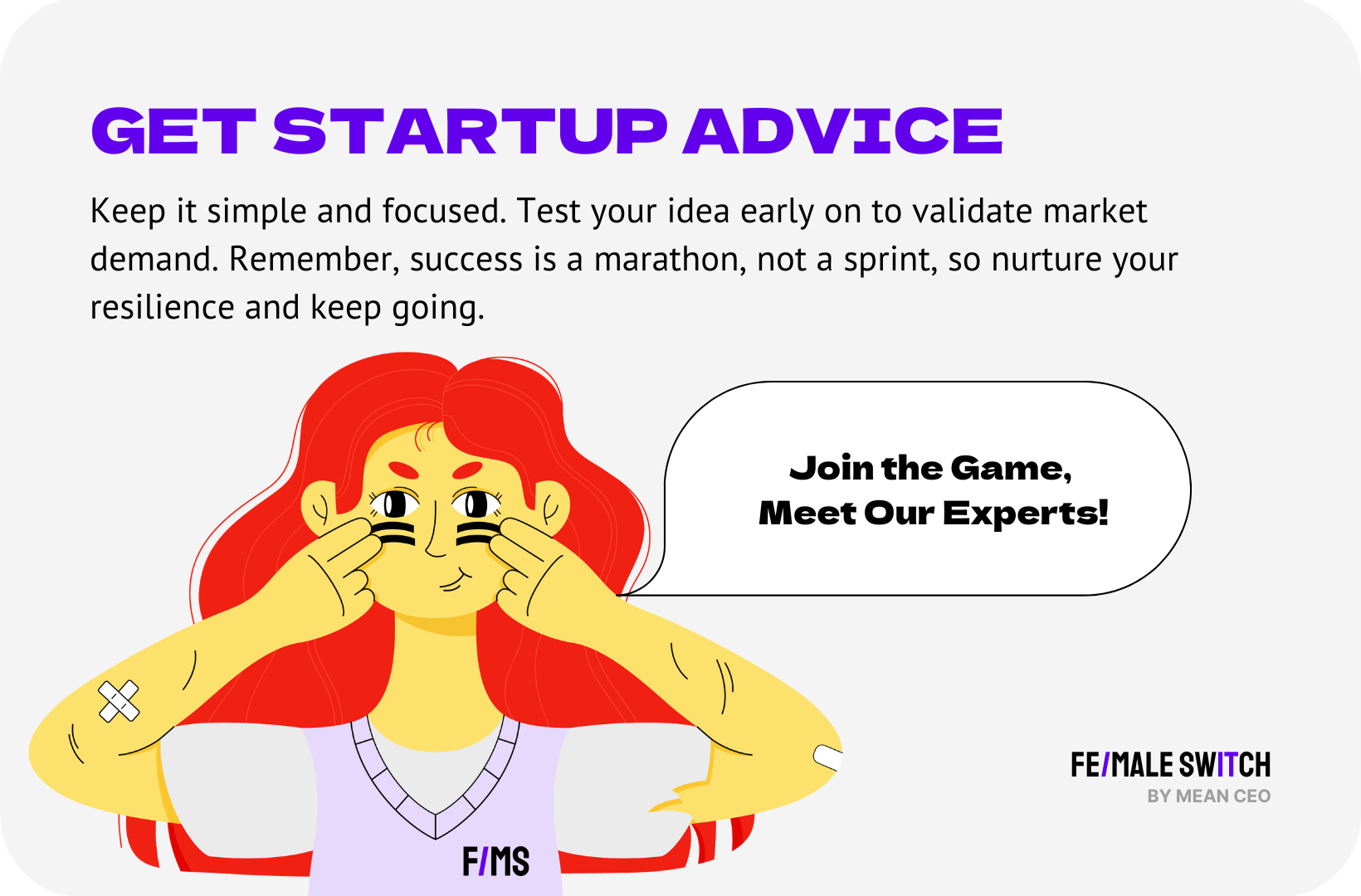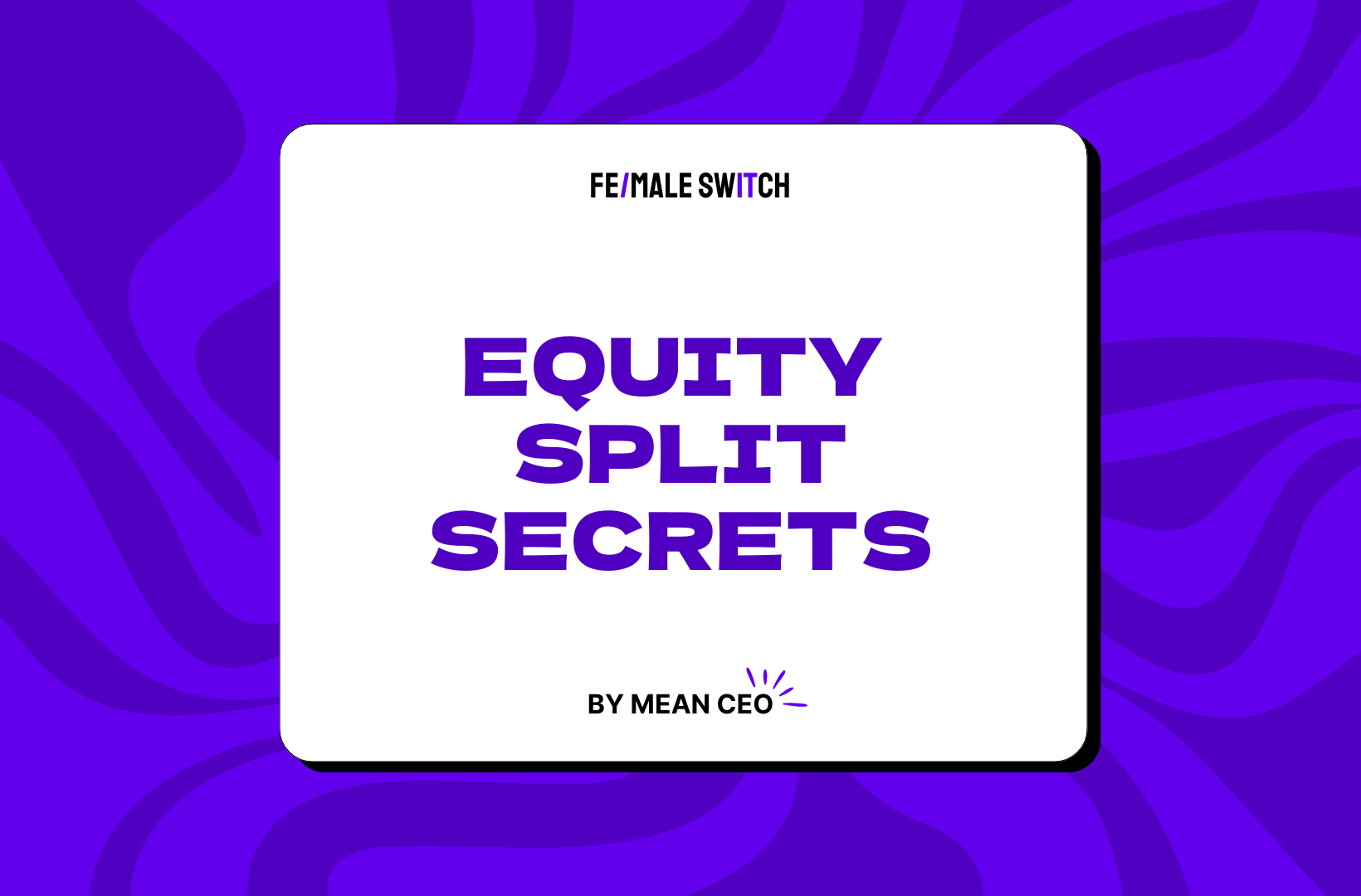TL;DR
Navigating the complex world of startup partnerships, Mean CEO, Violetta Bonenkamp underscores the essentials of a robust co-founder collaboration in a startup's infancy. She dives into the art of finding the perfect business co-founder through networking and leveraging complementary skills, shaping the foundation for successful ventures with clear roles and responsibilities using tools like Make and Tilda. Bonenkamp, a pioneer in "gamepreneurship" and founder of Fe/male Switch, imparts her wisdom on fostering long-term success and avoiding common equity distribution pitfalls.
In the realm of equity negotiations, Violetta stresses the significance of early, intentional conversations informed by key factors like intellectual property and risk assessment. She boldly confronts the nuances of equity splits with strategies that ensure alignment between short-term effort and long-term vision, backed by experience from her work on Fe/male Switch, the free women-first startup game. With her track record as a successful entrepreneur, Bonenkamp delivers insights with a twist—perfect for budding entrepreneurs looking to merge startup dreams with reality, alongside Mean CEO and her AI co-founder, Elona Musk.
Introduction
Picture this: You've launched a startup with dreams as high as European skyscrapers, eager to be the next tech sensation. But wait, there's a problem lurking in the co-founder's suite—a Gordian Knot that can make or break your success story: equity split. How do you slice the equity pie without creating a recipe for resentment? Agitated at the thought of having "the talk" with your partners? You're not alone; even the titans of tech had to crack this code. Bill Gates and Paul Allen went for a 64-36 split, while the Google guys stood firm at 50-50.
I'm Violetta Bonenkamp, but you can call me MeanCEO, and I'm here to guide you through the treacherous terrain of equity division with a mix of personal anecdotes and no-nonsense advice. When it comes to startups, getting the equity split right is as vital as your morning espresso shot. As the brains behind Fe/male Switch and a startup whisperer, I've seen my fair share of equity battles. It's time to tackle this beast with clarity and purpose, because let's face it, a successful equity split strategy could mean the difference between a European startup's triumph and its downfall. Ready to dive in? Let's get controversial, personal, and above all—practical.
Establishing a Robust Co-Founder Partnership
How to Find a Business Co-Founder for Your Startup
Scouting for the perfect business co-founder is much like finding a needle in a haystack; it's challenging but not impossible. Networking events, incubators, and co-working spaces are the nurturing grounds for potential co-founders, especially if you're after someone who shares your entrepreneurial spirit. How to find a business co-founder doesn't have a one-size-fits-all answer, yet diving into entrepreneurial communities can open doors to like-minded individuals. In the digital era, leveraging social media and online matchmaking platforms like Founder2be can expedite the process of finding someone whose vision aligns with yours.
Finding that match, however, involves more than a shared vision; it's critical to seek out complementary skills that will fill the gaps in your startup's needs. A tech wizard might jive perfectly with a marketing maestro, creating a dynamic duo that can innovate and strategize in unison. The synergy of diverse, yet complementary skills ensures that both founders can confidently navigate through various aspects of the business.
Equally crucial in co-founder selection is the alignment of core values and the endgame. It's like heading on a cross-country road trip; you wouldn't embark on that journey without agreeing on the destination and the route. So, make sure you're both plotting the same path on the startup map.
Defining Roles and Responsibilities of Company Founders
Establishing clarity in the operational roles and decision-making power is akin to setting up the rules of a board game; you've got to know who's responsible for what, and who has the final say in crucial decisions. This clarity helps dodge bullets of uncertainty and conflict down the line. It's important for co-founders to sit down and thrash out a comprehensive list of roles, defining the responsibilities of company founders right from the get-go.
When it comes to collaboration strategies amongst co-founders, think of it as a synchronized dance routine. It requires practice, communication, and, most importantly, the ability to anticipate each other's moves. Techniques such as regular check-ins or employing collaborative zero-code tools like Tilda can help manage workloads and keep everyone in the loop.
Utilizing zero-code platforms doesn't just support division of labor, it empowers each founder to create and iterate without needing to rely on technical teams for every tweak or test. These tools can be a game-changer in efficiently managing the overlapping and individual tasks that come with running a startup.
Understanding the Difference Between Founder and Co-Founder Dynamics
Embarking on a startup venture requires a profound understanding of the difference between founder and co-founder dynamics. It’s about realizing that while both may hold leadership titles, their ownership and responsibilities might differ. Leadership in a startup is nuanced; it requires ensemble play where each co-founder's unique abilities shine in concert with the others.
Fair distribution of work and accountability isn't simply a fancy phrase—it's the cornerstone of a smoothly operating startup. This entails a clear delineation of who's accountable for what, ensuring no tasks fall through the cracks. It's not unlike a tag-team match where each player knows exactly when to step in and when to support from the sidelines.
Lastly, nurturing successful co-founder partnerships in startups isn't just about passing the baton back and forth; it's an ongoing commitment to continuously invest in the relationship. This might involve seeking external advice or mentorship to keep enhancing the partnership dynamic. The goal is to achieve a partnership where mutual respect, trust, and an unflinching commitment to the startup's success are the guiding principles.
For more insight on the critical components of co-founder relationships, take a look at the article on Co-Founder Equity Splits—Ways to Approach Allocations, which further emphasizes the importance of equity fairness and mutual understanding.

5 Steps to a Successful Equity Split in Your Startup
1. Find Your Business Soulmate
Head to those networking events or log into co-founder dating platforms with the zeal of a love-struck teenager. Remember, you’re not just looking for skills; you’re after that visionary who shares your dream and complements your craziness.
2. Define Who Does What
It’s like dividing chores in a shared apartment. Get clear on roles and tasks right from the get-go to prevent domestic—err, entrepreneurial—spats. And hey, don’t forget to leverage those nifty zero-code tools like Tilda to keep track of who’s doing what.
3. Talk Money Without the Awkward Silence
Bring up equity distribution. It’s like discussing who's to pay on a first date, but trickier. Use tools like AI simulations to navigate these waters. Aim for a fair split that considers sweat equity, financial injections, and midnight oil burned.
4. Paper It Up Legally
Draft a co-founder agreement like you’re writing the plot of your life movie. Be detailed, cover every angle, and make it legally binding. There’s no such thing as being too melodramatic here. Use Bubble or Adalo to simplify the bureaucracy.
5. Keep the Romance Alive
Treat your business partnership like a marriage. Schedule regular check-ups, communicate, and adapt. And when things get rocky, consider a startup couple's therapy with some executive coaching.
Equity Distribution and Negotiation Strategies
Equity Distribution for Startup Founders: Making the Right Decisions
Crunch time, folks – deciding equity distribution among co-founders is like dividing the last slice of pizza at a startup party – everyone's hungry for a piece! The tricky part? Understanding just how impactful various types of contributions are. We tend to focus on the tangible stuff – cash, property, maybe that high-tech espresso machine – but sweat equity is a hardworking gladiator in this arena. Think late-night coding marathons and the all-hands-on-deck action it takes to get a startup off the ground.
Speaking of sweat equity, it's not just about effort—thinking it's like a gym membership with a flat rate for everyone is where you risk tripping on the treadmill. To strike a balance between financial and non-financial contributions, you've got to open up the conversation channels. Don't leave this chat until Sunday brunch; it's a discourse worth starting early with your co-founders over your computer screens or artisan coffee – wherever ideas flow and decisions can be sculpted.
Tools like Tally (https://tally.so/) add transparency to the mix – because, let's face it, these discussions need to be as clear as your grandma's spectacles. With such platforms, you can lay out each co-founder's roles like tarot cards, revealing the future value and current input honestly. Remember, equity isn't just a slice of the pie; it's the flour that binds it – so mix it wisely!
Key Factors Influencing a Fair Startup Equity Split
Little did I know when launching my startup that intellectual property wasn't just a buzzword – it's heavyweight equity gold. Assigning value to this treasure chest can feel like pinning down a cloud. But here's the rub: the code your CTO whips up has weight in gold, so if someone's crafting digital artistry that'll be the backbone of your business, they'll want their fair share of the claim.
When you're in the trenches of startup life, risk assessment is your commando knife. Measure the lengths each co-founder is willing to go – are they ready to dive into shark-infested waters for your tech baby? Full-timers usually get a bigger share of the pie, and if they're staking their last cent on this dream, consider that a Texas-size claim for equity. Remember, a successful co-founder partnership in startups values both risk and commitment.
Now let's add a tiny sprinkle of strategy here. Using equity to snag top talent early on can be a game-changer. It's like a magnet for brainy folks who might otherwise stroll past your humble garage-turned-office. You're not dangling just a paycheck, but a shot at being part of startup lore. Draw them in early with an equity hook, and watch them help you reel in the big fish!
Executing a Collaborative Approach to Co-Founder Equity Negotiations
Okay, gear up for some 21st-century haggling! Co-founder equity negotiations aren't your Grandma's yard sale bargaining – these are high stakes, all-in conversations. You know what's the secret sauce here? AI, my friends. When you harness AI tools, you turn the negotiation table into a strategy game where everyone knows the rules and the playing field is as level as Kansas.
Preparing to be equitable with equity? Role-play some scenarios – Who's the decision-maker? The creatrix? The fundraiser? – and chalk it out. Tools like Make (https://www.make.com/en) smooth out the process, allowing you to automate scenarios and see who shines in what domain. You're not just throwing numbers around; you're crafting a script for startup success.
Be the startup equivalent of a wise owl and foster alignment between immediate grunt work and distant glories. Zapier (https://zapier.com/) spruces up the efficacy, automating the mundane to focus on strategies that pay off in the long haul. So when you split that equity, ensure it's not just for today's toil but for the marathon run to that champagne-popping series A funding down the road.
For more on how these tools can revolutionize your startup journey, check out "Co-Founder Equity Splits—Ways to Approach Allocations" – it's your navigator through these choppy entrepreneurial waters.

Building Strong Foundation with Co-Founder Agreements
Crafting Comprehensive Founder Agreements
Snag yourself a rock-solid co-founder agreement, it's not just a handshake deal, folks. This beauty should shine like a gem, covering roles, equity splits, and an exit strategy just in case someone decides to bail. Think of it as the relationship prenup – not romantic, but boy, does it save headaches later. To nail one down, avoid the "we’ll figure it out" approach; lay everything out like a Thanksgiving feast. And if legalese isn’t your first language, tools like Bubble and Adalo can help you draft agreements that wouldn't scare off a law-savvy shark.
Protecting All Parties Legally
Getting your co-founder agreement down on legally-binding paper is like suiting up for battle. No handshakes or pinky promises here – solidify that partnership with the power of the pen and the might of legal binders. You want a fortress, not a cardboard box, protecting your shared brainchild from unforeseen squabbles or the ever-dreaded founder fallout. Make sure those documents are as bulletproof as Kevlar – it’s a chunk of work now, but it’s less of a migraine when you’re scaling up and counting your billions.
Streamlining Administrative Workflows
Don't let admin tasks be your startup's deadweight. Embrace tools like Bubble to cut through the red tape like a light saber through butter. These platforms are gold mines for automating the dullest of tasks, so you can focus on world domination – or at least market domination. They handle the tedious stuff, leaving you free to negotiate collaborations or strut your stuff at pitch fests. It’s like having a virtual secretary who doesn’t require coffee breaks.
Maintaining a Healthy Co-Founder Relationship Through Growth
Open Communication is Key
Communication isn’t just chitchat over espresso – it’s the glue that keeps relationships tight. Schedule regular check-ins, where you’re brutally honest about what’s rocking and what’s flopping. And keep it as transparent as a freshly-cleaned window. Remember, assumptions are the termites of relationships; talk it out, clear the air, laugh over blunders – it’ll keep you sailing straight when the high seas of startup life get choppy.
Conflict Resolution Strategies
Butterflies and rainbows are great, but even the best partnerships hit snags. If disagreements are on the menu, pass the mediation gravy, and bring in an executive coach like they’re the cavalry. Resolving conflicts is an art; it's about finding common ground, not drawing battle lines. It’s like a detour sign on the road to success – reroute, recalibrate, and keep pushing to that next milestone.
Adapting to Growth
Adaptability isn’t just for Darwin’s finches. Embrace change like it’s going out of fashion, especially when your startup’s scaling faster than a squirrel on a sugar rush. Flexibility and resilience are the names of the game – be ready to pivot, reinvent, and LOL at the chaos. Because when it comes down to it, growth is messy, unpredictable, and downright exhilarating.

Celebrating Successful Co-Founder Partnerships and Learning from Them
Analyzing Case Studies
Feast your eyes on case studies of winning co-founder teams – it's like reading the playbook of champs before hitting the field. These tales of victory (and woe) shed light on the alchemy of co-founder magic. Look beyond the hype, find those nuggets of wisdom, and replicate their savvy moves. Think of it as borrowing the secret sauce from the best chefs in the startup kitchen.
Best Practices and Pitfalls
Navigate the tightrope of partnerships with the balance of a circus performer, embracing best practices while sidestepping pitfalls like a pro. It's about learning the moves, watching where others stumbled, and doing a neat sidestep. Be strategic in relationship building, keep egos on a tight leash, and don’t let past mishaps torpedo future success.
Continuous Learning and Collaboration
Keep your brain as fed as your ambition. Swallow down those books, podcasts, and webinars like they’re gourmet brainfood. Mix it up with industry mentors who've weathered storms and can navigate by the stars. It's a network of wisdom at your fingertips, folks – find those Jedi masters, soak in their knowledge, and supercharge your startup journey.
For some stirring stories of co-founding teams that turned the startup world on its head, feast on "How to be a Great Founder." This gem is packed with the wisdom you need to navigate the high seas of startup collaboration.

Conclusion
When it comes to the art – yes, art – of an equity split, you'd think it’s as simple as slicing a pie. But no, it's more like crafting a carefully balanced recipe where every ingredient must be measured with precision. Your split should reflect the value each founder brings to the startup’s table, be it brain-bending IP, sweat equity, or cold hard cash. Weigh the factors: commitment, expertise, responsibilities, and risks like a pro. Don't shy away from this convo; it's as crucial as deciding on your company's name. Tabletowels, anyone? Remember, a lopsided equity split could have investors arching a quizzical brow, wondering if the team dynamics are as skewed as the split itself.
In a nutshell, a successful equity split isn't about cutting cake at a birthday bash and everyone getting an equal slice. It’s about reflecting true value add, long-term goals, and keeping founders motivated. So strap on your negotiation hat, pop a cork of intention, and let's hash out an equity plan that’ll keep everyone from the coder to the coffee-fetcher locked in and paddling the boat merrily down Startup Stream. After all, an equitable equity split is the secret sauce to ensuring that your startup journey is more smooth sailing than tempest-tossed. 🚀🌊
FAQ
How do you decide equity split between founders?
When it's time to slice the equity pie, founders should consider not just the initial contribution but the long-term value they bring to the table. Time, money, relationships, ideas—they all factor in. It's like playing poker; you've got to know what's in your hand and assess the pot's worth. A transactional approach might be your best bet, placing value on each contribution to determine who gets the bigger piece of the startup cake. For some founders, it's about finding that balance between equity and motivation. Need a little guidance from savvy business minds who have been there, done that? Check out the lowdown at Harvard Business School Startup Guide.
How do you distribute equity between co-founders?
In the startup game, equity distribution can be a dance of strategy and foresight. It typically starts with a whole pie divided, maybe equally, maybe not—depending on who brought the secret sauce. As the company grows, those who pony up the dough or sprinkle wisdom and experience into the mix might snag a slice. It's a mix-and-match balancing act you need to get just right. If you're pondering the fair share shuffle, take a peek at the playbook over at Cake Equity for some tasty advice.
How much equity should I give a co-founder?
Equity isn't just a piece of paper—it's the heart of your startup's future. Every co-founder's slice should echo the value they're expected to add. For co-founders whose contributions are as evenly matched as a pair of socks, the equity could be split down the middle (think 51/49). But this isn't a one-size-fits-all; every startup's got its unique recipe. Get into the nitty-gritty with Justin Kan's nuggets of wisdom at LTSE Insights.
How to divide responsibilities between co-founders?
Divvying up roles among co-founders isn't your average pie-slicing exercise—it's about playing to each person's strengths. Think of it as a superhero team-up; each member has unique powers to bring to the table. Skills, interests, company needs, and individual capacities all go into the mix. The goal? A balanced team where skill sets complement, responsibilities fit, and no one is wearing too many hats. For a deep dive into creating a well-oiled co-founder machine, march over to Tactyqal.
When should startup founders decide on the equity split?
In the early scramble of startup life, founders should plot out the equity map sooner rather than later. Avoiding the conversation could lead to friction down the startup road, with contributions and commitment levels at stake. It's like cleaning your room; nobody wants to do it, but you'll thank yourself later. Have a candid chat, set clear terms, and make sure everyone feels heard. It's a crucial step in your startup journey, just like that first sip of coffee in the morning. Dig into the how-tos with the real-talk folks at Antler Academy.
Can splitting equity determine a startup's success?
You bet your bottom dollar it can! Splitting equity is like assigning seats in a music band—get the balance right, and you're on your way to hit-making glory. Allocate it fairly based on contributions, potential, and risks taken, and you'll have a motivated crew eager to toil for those elusive treasures at the end of the rainbow. It's about incentives, commitment, and long-term vision. Call it equity alchemy. For harmonious distribution that sings, groove over to Failory's guide.
What happens if co-founder equity is split unequally?
An unequal co-founder equity split can be the apple of discord, making or breaking your startup symphony. It may reflect the value brought to the table, but brew resentment if not aligned with contribution perception. Imagine a cake where one gets a thin slice while the other takes the chunk with the cherry! It's crucial to keep the peace and remember that equity isn't just about now—it's about the sweat, tears, and late nights ahead. To avoid diving into the deep end without a life jacket, take lessons from those who've weathered the storm at Y Combinator's Library.
Should co-founder equity be revisited over time?
Absolutely, just like your favorite streaming series needs a season refresh. Revisiting the equity agreement allows for adjustments based on evolving roles, contributions, and business milestones. Think of it as your startup's health check-up; it keeps things fair and square. It's not a set-it-and-forget-it affair; it needs nurturing like a delicate houseplant. Keep equity alignment in check by tapping into the wisdom from Carta's learning center.
Is a 50/50 equity split advisable for co-founders?
Ah, the classic 50/50 split—it's like the cozy middle of the bed, tempting, but could it lead to squabbles down the line? Advisable or not, it comes down to context. For co-founders tighter than peanut butter and jelly, where their inputs and roles align flawlessly, it's sweet harmony. Yet, for others, a tailored approach that reflects individual input and risk might be the better jam. To crunch numbers without the headache, explore the tools over at Silicon Valley Bank's startup insights.
How flexible should equity agreements be for startups?
Equity agreements should be as flexible as a gymnast, able to bend in the winds of change without snapping like a twig. Early-stage startups are like unpredictable toddlers; needs and roles evolve. Clauses that allow for changes keep your startup staying limber. Think right of first refusal, buy-backs, and vesting terms. Flexibility in your equity agreements means you’re ready for life's twists, turns, and flips. Keep that flexibility game strong by reading up on Quora discussions.
Additional Resources
For those diving into the entrepreneurial landscape or seeking to fortify their startup arsenal, here's a lineup of ten stellar articles and tools tailored to guide and galvanize your entrepreneurial spirit:
- How to find a Co-Founder for Your Startup and what to ask them - Identify the right questions to pinpoint the perfect companion in entrepreneurship.
- Validating a Product Without Having the Product - Master the art of proving your concept before hitting the market full-force.
- How to Be a Great Founder - Unveil the traits that set apart exceptional startup founders.
- Top 20 Essential Skills for Successful Startup Founders - Elevate your entrepreneurial prowess with these must-have skills.
- 5 Reasons Why You Need a Mentor - Discover why mentorship can turbocharge your journey to startup success.
- Failing Your First Startup is the Best Way to Success: The Mean Startup Method - Grasp the lessons that come from failing forward, an essential step on the road to triumph.
- Controversial Debate: Is a Technical Co-Founder Really Necessary for Startup Success? - Join the debate on the value of technical vs. non-technical co-founders.
- Speaking Facts: Female-Founded Startups Are Destined to Bring More Profit - Learn about the tangible benefits female leadership brings to the startup world.
- Will AI Take My Job in 5 Years? Tool - Evaluate how AI advancements might impact your industry and future-proof your role.
- Become a Prompting Queen and Get Awesome AI Results - Leverage AI effectively to yield astounding results for your startup.


